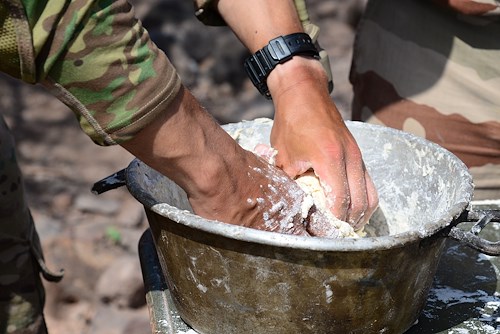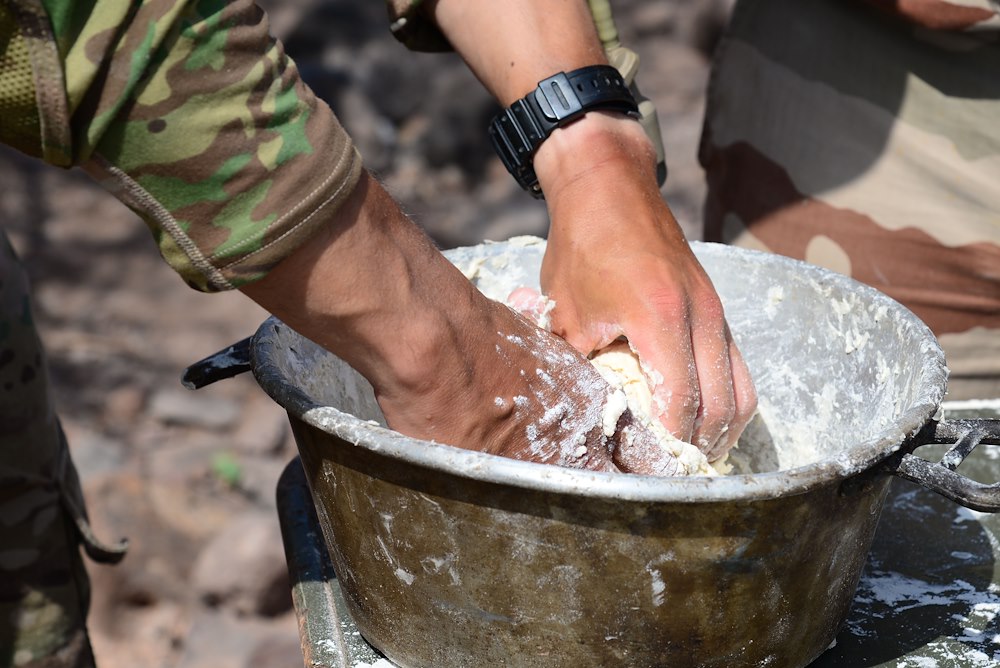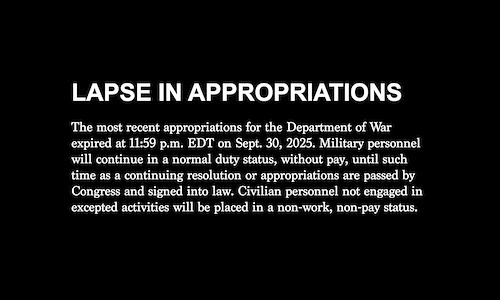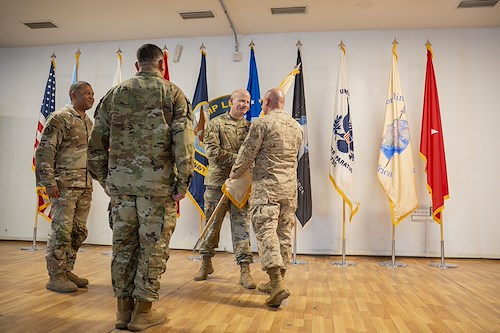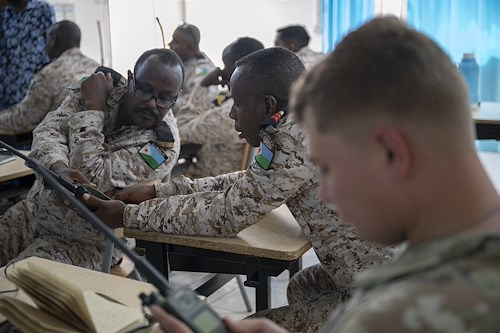Gallery contains 8 images
×
Photo 1 of 8
Combined Joint Task Force - Horn of Africa Image
U.S. Army 1st Lt. Anthony Barnett, 2nd Battalion, 124th Infantry Regiment, kneads dough to make bread during the French Desert Survival Course, May 5, 2016, at Arta Plage, Djibouti. During the course, U.S. forces also learned how to prepare tea and meat in austere environments. (U.S. Air Force photo by Senior Airman Benjamin Raughton/Released)
Photo by: Senior Airman Benjamin Raughton
Photo 2 of 8
Combined Joint Task Force - Horn of Africa Image
A U.S. Army soldier lifts barbed wire with his boot during the French Desert Survival Course, May 6, 2016, at Arta Plage, Djibouti. The team of 10 soldiers were able to safely maneuver through a barbed wire field by lifting the barbs with their feet allowing the next soldier to move past. (U.S. Air Force photo by Senior Airman Benjamin Raughton/Released)
Photo by: Senior Airman Benjamin Raughton
Photo 3 of 8
Combined Joint Task Force - Horn of Africa Image
A U.S. Army soldier swings from a ledge to a rope ladder during the French Desert Survival Course, May 6, 2015, at Arta Plage, Djibouti. The mountain obstacle course is the final test, requiring nearly every skill set learned in training, and must be completed in a strict 25-minute time limit to graduate the course. (U.S. Air Force photo by Senior Airman Benjamin Raughton/Released)
Photo by: Senior Airman Benjamin Raughton
Photo 4 of 8
Combined Joint Task Force - Horn of Africa Image
U.S. Army Spc. Steven Saurimayo, 2nd Battalion, 124th Infantry Regiment, climbs a rope obstacle during the French Desert Survival Course May 6, 2016, at Arta Plage, Djibouti. The U.S. forces were required to complete the obstacle course, and then perform the same course in reverse while carrying a tire that could not make contact with the ground. (U.S. Air Force photo by Senior Airman Benjamin Raughton/Released)
Photo by: Senior Airman Benjamin Raughton
Photo 5 of 8
Combined Joint Task Force - Horn of Africa Image
U.S. Army soldiers from the 2nd Battalion, 124th Infantry Regiment, paddle a zodiac watercraft across a beach during a water crossing exercise May 5, 2016, at Arta Plage, Djibouti. The soldiers completed the exercise as a team in less than 40 minutes. (U.S. Air Force photo by Senior Airman Benjamin Raughton/Released)
Photo by: Senior Airman Benjamin Raughton
Photo 6 of 8
Combined Joint Task Force - Horn of Africa Image
U.S. Army Staff Sgt. Charles Poole, 2nd Battalion, 124th Infantry Regiment, holds a balance beam steady for a teammate during the French Desert Survival Course, May 6, 2016, at Arta Plage, Djibouti. All participants were required to cross two beams while ensuring a tire didn’t make contact with the ground. (U.S. Air Force photo by Senior Airman Benjamin Raughton/Released)
Photo by: Senior Airman Benjamin Raughton
Photo 7 of 8
Combined Joint Task Force - Horn of Africa Image
U.S. Army soldiers from the 2nd Battalion, 124th Infantry Regiment, carry a zodiac watercraft across a beach during a water crossing exercise May 5, 2016, at Arta Plage, Djibouti. The soldiers were required to run the watercraft across a beach, paddle to a drowning victim, and run back and run back to the starting point. (U.S. Air Force photo by Senior Airman Benjamin Raughton/Released)
Photo by: Senior Airman Benjamin Raughton
Photo 8 of 8
Combined Joint Task Force - Horn of Africa Image
U.S. Army Spc. Zach Dean, left, and Jacob Currie, 2nd Battalion, 124th Infantry Regiment, use a stick, bow and paper to make a fire during the French Desert Survival Course, May 5, 2016 at Arta Plage, Djibouti. During the course, U.S. forces also learned how to make fire from mundane items like batteries, flint, bullets and steel wool. (U.S. Air Force photo by Senior Airman Benjamin Raughton/Released)
Photo by: Senior Airman Benjamin Raughton
More than 35 U.S. forces joined French Cadets, infantry and legionnaires to negotiate the French Desert Survival Course April 25 to May 10, in Djibouti.
The course exposed the forces to the fundamentals of desert combat, survival and troop movements while bridging language and cultural barriers between French and American troops. This evolution of the course also adds two U.S. Air Force instructors to the French instructor team.
“Not only does it teach infantry movements in the field and seizing different objectives, it teaches teamwork and camaraderie,” said Staff Sgt. Mark Eiden, a course instructor from the Air Force.
“[U.S. forces] get the opportunity to be here because we’re stationed at Camp Lemonnier and the infantry battalion has built good relationships with the school. It’s been valuable integrating U.S. and French assets together.”
Ludwig Grandjean, of the French 1st Cavalry Regiment, Foreign Legion, serves as a platoon leader for French troops participating in the course.
“When I work with American units, I see how you work against the enemy,” he said. “It allows me to improve my [skill]. It also gives me the opportunity to show you what the French can do underground against an enemy and [how] we can change, adapt and improve.”
Joint training in austere environments is beneficial, as the Djiboutian terrain is similar to that of Syria, Iraq, Afghanistan and Mali, he said.
Parts of the course had students learning how to collect water in the desert, make bread, and rice, find sources of meat, and learn other skills that could save their lives in the desert.
“In many conflicts and operations, we are working together, so this type of training in Djibouti allows us to discover other units and gives us an opportunity to prepare for future engagements and operations,” Grandjean said.
Grandjean emphasized the more French and U.S. forces learn about each other’s skill sets, joint operations will become easier.

